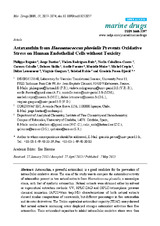Mostrar el registro sencillo del ítem
Astaxanthin from Haematococcus pluvialis Prevents Oxidative Stress on Human Endothelial Cells without Toxicity
| dc.contributor.author | Régnier, Philippe | |
| dc.contributor.author | Bastias, Jorge | |
| dc.contributor.author | Rodríguez-Ruiz, Violeta | |
| dc.contributor.author | Caballero-Casero, Noelia | |
| dc.contributor.author | Caballo Linares, Carmen | |
| dc.contributor.author | Sicilia Criado, María Dolores | |
| dc.contributor.author | Fuentes, Axelle | |
| dc.contributor.author | Maire, Murielle | |
| dc.contributor.author | Crepin, Michel | |
| dc.contributor.author | Letourneur, Didier | |
| dc.contributor.author | Gueguen, Virginie | |
| dc.contributor.author | Rubio Bravo, Soledad | |
| dc.contributor.author | Pavon-Djavid, Graciela | |
| dc.date.accessioned | 2017-11-09T11:58:05Z | |
| dc.date.available | 2017-11-09T11:58:05Z | |
| dc.date.issued | 2015 | |
| dc.identifier.uri | http://hdl.handle.net/10396/15395 | |
| dc.description.abstract | Astaxanthin, a powerful antioxidant, is a good candidate for the prevention of intracellular oxidative stress. The aim of the study was to compare the antioxidant activity of astaxanthin present in two natural extracts from Haematococcus pluvialis, a microalgae strain, with that of synthetic astaxanthin. Natural extracts were obtained either by solvent or supercritical extraction methods. UV, HPLC-DAD and (HPLC-(atmospheric pressure chemical ionization (APCI)+)/ion trap-MS) characterizations of both natural extracts showed similar compositions of carotenoids, but different percentages in free astaxanthin and its ester derivatives. The Trolox equivalent antioxidant capacity (TEAC) assay showed that natural extracts containing esters displayed stronger antioxidant activities than free astaxanthin. Their antioxidant capacities to inhibit intracellular oxidative stress were then evaluated on HUVEC cells. The intracellular antioxidant activity in natural extracts was approximately 90-times higher than synthetic astaxanthin (5 μM). No modification, neither in the morphology nor in the viability, of vascular human cells was observed by in vitro biocompatibility study up to 10 μM astaxanthin concentrations. Therefore, these results revealed the therapeutic potential of the natural extracts in vascular human cell protection against oxidative stress without toxicity, which could be exploited in prevention and/or treatment of cardiovascular diseases | es_ES |
| dc.format.mimetype | application/pdf | es_ES |
| dc.language.iso | eng | es_ES |
| dc.publisher | MDPI | es_ES |
| dc.rights | https://creativecommons.org/licenses/by/4.0/ | es_ES |
| dc.source | Marine Drugs 13(5), 2857-2874 (2015) | es_ES |
| dc.subject | Astaxanthin | es_ES |
| dc.subject | Antioxidants | es_ES |
| dc.subject | Haematococcus pluvialis | es_ES |
| dc.subject | Oxidative stress | es_ES |
| dc.subject | HUVEC | es_ES |
| dc.subject | TEAC | es_ES |
| dc.title | Astaxanthin from Haematococcus pluvialis Prevents Oxidative Stress on Human Endothelial Cells without Toxicity | es_ES |
| dc.type | info:eu-repo/semantics/article | es_ES |
| dc.relation.publisherversion | http://dx.doi.org/10.3390/md13052857 | es_ES |
| dc.rights.accessRights | info:eu-repo/semantics/openAccess | es_ES |

